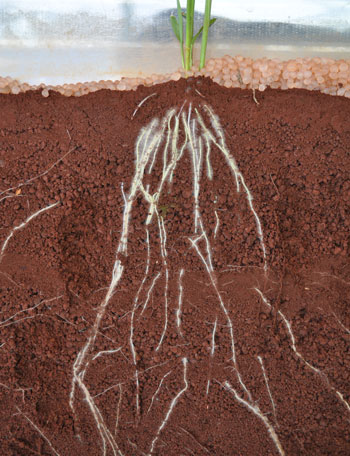Key Points
- Reserves of phosphorus and potassium vary widely in soils of the northern grains region but can be an important early warning system to guide fertiliser decisions
- There are no district-wide indicators of reserve phosphorus and potassium status
- We recommend growers and advisers assess reserve phosphorus and potassium every 10 years at surface and subsoil depths
While measuring available phosphorus and potassium is essential for seasonal fertiliser decisions, reserves can provide an early warning for future declines
Declining soil fertility in the northern grains region has led to novel fertiliser application and placement strategies and, importantly, an awareness of the changes in phosphorus and potassium availability that are needed to increase grain production and optimise fertiliser recovery.
Large reserves of phosphorus and potassium exist in some of these soils, but to date we have had limited understanding of how to quantify them and over what timeframe – and to what extent – they can supplement existing available sources.
A three-year GRDC investment in research at the University of New England and the Queensland Department of Environment and Science has shed some light on the nature of phosphorus and potassium reserves. In particular, it has improved understanding of their distribution across the region, measurement, availability to crop roots, and whether landscape changes (such as periodic flooding) or varying crop rotation (including more pulses) could increase crop availability.
The results show it is not possible to provide district-wide indicators of reserve phosphorus and potassium status, as cropping history and management result in wide variation in these nutrient pools. However, there is also no evidence that either episodic flooding or increased pulse rotations can accelerate the release of phosphorus or potassium from soil reserves into labile soil pools.
Measuring reserves
Monitoring available phosphorus and potassium in the surface (zero to 10 centimetres) and subsoil (10 to 30cm) is essential for providing seasonal fertiliser recommendations (see Table 1). We recommend growers and advisers also assess reserve phosphorus and potassium every 10 years at surface and subsoil depths to provide early warning of declining soil nutrient reserves. However, predicting the likely contribution of these reserves to crop nutrient requirements remains problematic, and seasonal fertiliser recommendations should not be adjusted for reserve phosphorus and potassium status.
Table 1: Soil testing recommendations for phosphorus and potassium in the northern grains region. Test both the surface (0–10cm) and subsoil (10–30cm).
Soil test timing | Phosphorus testing strategy | Potassium testing strategy |
|---|---|---|
<2 yearly | Available (Colwell P) Adjust critical value if PBI>250 | Available (Exchangeable K) Adjust critical value if CEC>20 and/or sodic |
<10 yearly | Reserve (BSES-P minus Colwell P) Consider replacement strategy if <1.5x Colwell P | Reserve (TBK minus Exchangeable K) Consider replacement strategy if <1.3x Exchangeable K |
Source: Chris Guppy
The key measures of these reserves in soils of the northern grains region were identified as the BSES-P soil phosphorus test (extractant: 0.005 molar sulfuric acid) and a one-hour tetraphenylborate extraction for potassium (TB-K). These are readily available through commercial and institutional labs, although TB-K is not undertaken as regularly as BSES-P. Preliminary evidence suggests mid-infrared spectroscopy (MIR) can produce a rapid and cost-effective estimate of reserve phosphorus and potassium, and further research may improve this diagnostic capability.
Adjusting fertiliser recommendations on the basis of BSES-P or TB-K results is not recommended, but periodic measurement of these pools will determine the size of the buffer that is slowing the decline in plant-available phosphorus and potassium pools.
Adjustment factors
We suggest PBI (corrected with Colwell P) and cation exchange capacity (CEC) should be factored into the critical ranges for Colwell P and exchangeable potassium.
 Measuring reserve phosphorus and potassium will help understand the size of the buffer that is slowing the decline in plant-available pools. Photo: Richard Flavel.
Measuring reserve phosphorus and potassium will help understand the size of the buffer that is slowing the decline in plant-available pools. Photo: Richard Flavel.
Most northern grains region soils (except ferrosols) have PBI values of 150–250, meaning applied phosphorus remains available to crops through the season, and unused phosphorus is likely to be available the following season. Responsive Colwell P levels in soils (less than 25 milligrams Colwell P per kilogram for most circumstances) need not be adjusted unless PBI values are above approximately 250.
Responsive exchangeable potassium levels increase with CEC because it takes an increasing amount of exchangeable potassium to maintain an adequate soil solution concentration as CEC increases. We suspect that while critical potassium values increase with CEC, they may not increase linearly above a CEC of 40 centimoles of positive charge per kilogram of soil.
Because we found little evidence that northern grain region soils ‘fix’ applied potassium, it is concluded that they do not contain appreciable amounts of potassium-fixing clay minerals such as illites or vermiculites. Regular potassium applications that replace the amount of potassium removed each year in harvested products should, therefore, be sufficient to maintain adequate levels.
Overall, this project has identified that reserve pools are important sources of phosphorus and potassium in some of the region’s soils, thereby buffering the plant-available pools. However, in making fertiliser recommendations, advisers should focus on the plant-available fractions of soil phosphorus and potassium, taking into account the relevant buffer capacity measures of PBI and CEC respectively.
*Dr Phil Moody passed away on 30 June 2020.
More information: Associate Professor Chris Guppy, 02 6773 3567, cguppy@une.edu.au

























































